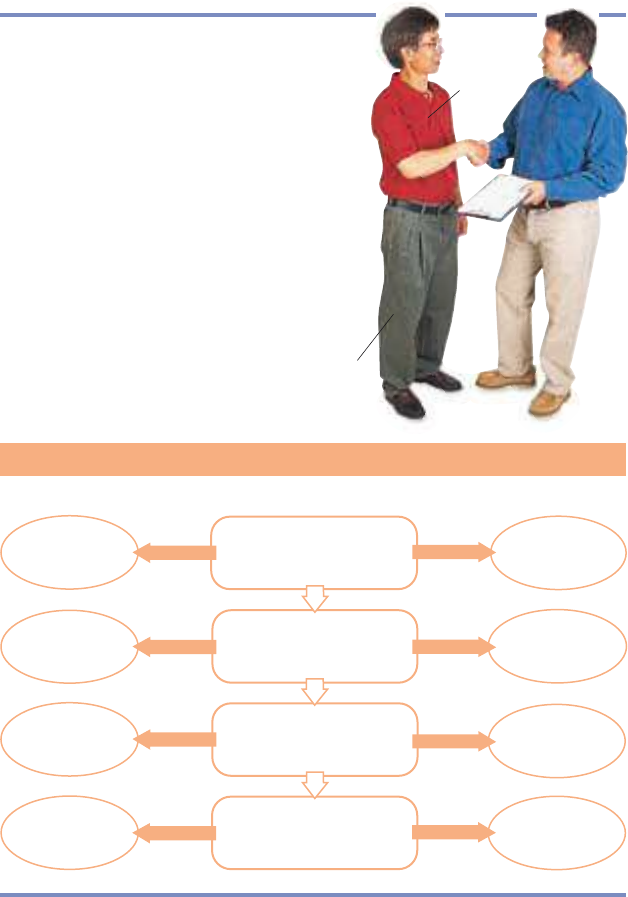
32
Training Your Memory
Remembering Names
M
any people struggle to remember
names. They try all kinds of memory
aids, with varying degrees of success, but
using a technique that is specifically for
learning names eliminates the need for
anything else and gives you total confidence.
USING THE
ASSOCIATION TECHNIQUE
When you remember someone’s name after
having met them only once, you make them
feel special. In a business situation, when
you are working with clients or customers,
it is an advantage to be able to call them
by their name. In the first crucial minutes
of meeting someone new, using their
name can help create a rapport between
you. There is a simple way to improve your
memory for names: the key is to tap into your
imagination. The technique for remembering
names long-term is known as the Association
Technique. It involves two steps: creating
an image and attaching it to a person.
●
Remember that every
piece of information in our
memory is in some way
connected to another piece.
FOCUS POINT
Looks at
photographs of a
family wedding and
is reminded of a
childhood vacation
Pick out names from the newspaper each
day or find a book of babies’ names. Practice
creating images for each one.
Begin by applying the name techniques to
individuals you already know, then proceed
to new people.
Explain the techniques to other people. Apart
from helping you consolidate them, this is fun,
and a great icebreaker in a social situation.
Useful Exercises
Bringing back memories
Memory works by association, so a
photograph of one event often brings
another occasion to mind. The same
principle of association can be used
to memorize and recall names.

Remembering Names
33
CREATING AN IMAGE
FROM A PERSON’S NAME
When you first hear a person’s name, immediately
create an image in association with it. Learn to
listen to and use the associations that come into
your brain first—these are the ones your memory
will find easiest to recall. For example, the name
Julie might prompt an image of jewelry because
the words sound similar, while Bill might make
you think of a dollar bill. The surname Booth
might bring up the picture of a telephone booth,
or Singh might make you think of a microphone
used for singing. Observe the person’s face to fix
it in your mind, looking for distinctive features.
ATTACHING THE IMAGE
After you have met the person, use the Image
Creation Principles to elaborate the image you
have created for the name, then attach it to the
person. For Julie, your image was jewelry—you
might see her wearing a mass of jewels. Make the
image stronger by imagining them
shining brightly, hurting your
eyes. Hear the chink of her gold
chains as she walks. When you
meet the person again, seeing
their face prompts you to
recall the image and that
triggers their name.
•
Being able to remember
names helps you professionally
as well as socially.
•
The first thing that comes
into your head is often the
most memorable association.
•
When you first meet
someone, it helps if you notice
something distinctive.
•
The Association Technique
can be used together with
Image Creation Principles.
At a Glance
Notices unusual
shirt and uses
this as his image
Attach image
Create image
Listen to name
Using association
Train yourself to let an image come into
your head when you first hear someone’s
name. Then create a link in your mind
between the image and the person whose
name you are memorizing.
Looking for a link
When you first meet someone,
notice anything distinctive—for
example, a colorful shirt—and
link it to their name.
Mentally exaggerates
the shirt to make it
more memorable

34
Training Your Memory
USING THE SLUG TECHNIQUE
A second system to help memorize names is
known by the acronym SLUG. The letters stand
for Slow down the introduction, Listen to the
name, Use the name, Go over the name. When
you are first introduced to someone (this is when
the new name is most easily lost) there is usually
very little time to implement the Association
Technique effectively. The SLUG Technique is
a simple, four-stage process that gives you a
chance to capture the name and recall it in
the short term—when most people forget it.
Slowing the introduction
The more time you take over an
introduction, the more likely you are to
catch the other person’s name in the first
place and then to remember it.
Use the name
Slow down the
introduction
Use name three
times during
conversation
Concentrate
hard when name
is first given
Have a brief
conversation
Repetition
of name cements
it in memory
Name may not
be used again after
introduction
Improves chances
of remembering
name
Listen to the name
Go over the name
Review name at
end of day and
again next day
Recall is lost if
not reviewed within
48 hours
Listens
carefully
to name
Uses name
in greeting
Using the SLUG Technique
Action to Take
Reason for Action

35
LISTENING, USING,
AND REVIEWING
If you do not listen to the other person’s
name in the first place, you may find there is
no chance of picking it up later on. So make
a point of concentrating at the moment their
name is given to you, and consciously take it
in. Next, it is vital that you actually use the
new name. If possible, use it three times during
your first meeting—immediately after you are
introduced, during your conversation, and
when you say goodbye. Even if it is just a brief
introduction, you can still acknowledge the
person by name. Finally, it is crucial that you
remind yourself of the name shortly after you
part company, and then again the next day—
nearly 80 percent of new information is forgotten
within a day or two if it is not reviewed.
COMBINING TECHNIQUES
Both the Association Technique and the
SLUG Technique work very well on their own
for memorizing names. However, to strengthen
the chances of remembering a name when you
meet someone new, you can also use both
techniques together. Apply the SLUG Technique
while you are being introduced to the other
person and then, either during or after the
conversation, use the Association Technique to
link the name to the person. In this way, both
the person and their name are stored in your
memory and can easily be recalled when you
next meet them or need to use their name.
Remembering Names
NAME: Li
ISSUE: Embarrassment
OBJECTIVE: To
remember names
Li finds she recognizes
people, but cannot recall
names. She decides to try
out memory techniques.
When she is introduced to Joe,
she looks him in the face and
notices a distinguishing feature.
She uses his name several
times. After they part, she
exaggerates that distinctive
feature in her mind, and links
it with the name Joe. Later, and
the next day, she repeats his
name. When she meets Joe a
year later, she is pleased to find
she remembers his name easily.
Case Study
“
Forgive your enemies, but never
forget their names.
”
John F. Kennedy
●
Ask a question when
you first meet someone,
perhaps about the journey.
This creates rapport—and
slows the introduction.
●
Shortly after you have
met someone new, make a
conscious effort to find an
image to which you can
attach their name.
FOCUS POINTS
..................Content has been hidden....................
You can't read the all page of ebook, please click here login for view all page.
